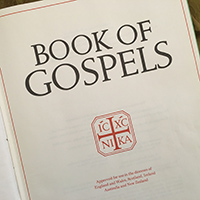 According to ancient tradition in the Church, the Book of Gospels is carried in the entrance procession at Mass, placed on the altar, and then ceremonially taken to the ambo for the proclamation of the Gospel. The Book of Gospels has always been given special respect and dignity in the Church because it is an icon of the presence of Christ to the liturgical assembly. Continue reading “A BOOK OF GOSPELS”
According to ancient tradition in the Church, the Book of Gospels is carried in the entrance procession at Mass, placed on the altar, and then ceremonially taken to the ambo for the proclamation of the Gospel. The Book of Gospels has always been given special respect and dignity in the Church because it is an icon of the presence of Christ to the liturgical assembly. Continue reading “A BOOK OF GOSPELS”
WILLIAM WARDELL’S LADYE CHAPEL
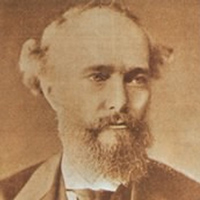 St Patrick’s Cathedral, Melbourne, Victoria
St Patrick’s Cathedral, Melbourne, Victoria
The nineteenth-century Gothic Revival Cathedral of St Patrick’s, Melbourne, Victoria (1858-1899, 1930s, 1970s, 1990s) is a place for Christian worship. It is a house of prayer, a dwelling-place of the Lord among God’s people. St Patrick’s has been part of my life since before I was born. In 1950, my Swiss-Polish parents, new post-WWII immigrants, were married in the cathedral sacristy by a Polish priest. The architect of the cathedral, William Wilkinson Wardell (1823-1899), became the topic of my doctoral research in the 1980s; and in the early 2000s my youngest daughter was married in the cathedral. It was in the 1990s that I began visiting the Ladye Chapel whenever I was in Melbourne. My younger brother was diagnosed with cancer in his mid-twenties and I found great comfort in simply being present with Mary, mother of us all.
TOM BASS: in his own words
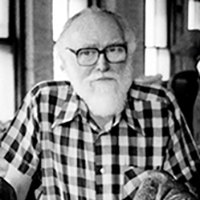 The Australian sculptor, Thomas Dwyer Bass am, was born in Lithgow in 1916. After various jobs during the Depression and army service during WWII, he began his career as a sculptor on graduating from the National Art School in 1948. Prior to the war, Bass attended Dattilo Rubbo’s art school; it was here he was initiated into the principles of art. At the National Art School he came under the influence of Lyndon Dadswell whose assistant he became during 1949-1950. This was followed by a three-year stint of teaching there. From 1951-1964 he held various executive positions with the Sculptors’ Society, of which he was a founding member. Continue reading “TOM BASS: in his own words”
The Australian sculptor, Thomas Dwyer Bass am, was born in Lithgow in 1916. After various jobs during the Depression and army service during WWII, he began his career as a sculptor on graduating from the National Art School in 1948. Prior to the war, Bass attended Dattilo Rubbo’s art school; it was here he was initiated into the principles of art. At the National Art School he came under the influence of Lyndon Dadswell whose assistant he became during 1949-1950. This was followed by a three-year stint of teaching there. From 1951-1964 he held various executive positions with the Sculptors’ Society, of which he was a founding member. Continue reading “TOM BASS: in his own words”
MARY MACKILLOP IN ADELAIDE
 The bronze sculptures of Judith Rolevink at St Francis Xavier Cathedral, Adelaide.
The bronze sculptures of Judith Rolevink at St Francis Xavier Cathedral, Adelaide.
The first sculpture dates from 2009 and stands beside the cathedral in Mary MacKillop Plaza. It is a narrative work that shows Mary holding hands with two children as they walk together. The trio steps forward joyfully. Continue reading “MARY MACKILLOP IN ADELAIDE”
CREATION WINDOWS – Cathedral Cairns
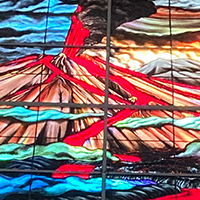 Embracing local holidays in Queensland recently, I found myself in St Monica’s Cathedral in Cairns for the first time in over twenty-five years. I was at last able to behold the magnificent creation windows made in the second half of the 1990s by Gerry Cummins and Jill Stehn. There are twelve windows on each side of the nave, each one measuring 6.5 metres by 1.6 metres. They are a monumental presentation of the Genesis story of the creation of the world, and include many scientific elements in the design together with frequent visual references to the Cairns topography, flora and fauna. They create a dynamic context for liturgy which is both cosmic and local.
Embracing local holidays in Queensland recently, I found myself in St Monica’s Cathedral in Cairns for the first time in over twenty-five years. I was at last able to behold the magnificent creation windows made in the second half of the 1990s by Gerry Cummins and Jill Stehn. There are twelve windows on each side of the nave, each one measuring 6.5 metres by 1.6 metres. They are a monumental presentation of the Genesis story of the creation of the world, and include many scientific elements in the design together with frequent visual references to the Cairns topography, flora and fauna. They create a dynamic context for liturgy which is both cosmic and local.
Working Together
 The Art and Architecture Committee of Sacred Heart Parish, Sandringham.
The Art and Architecture Committee of Sacred Heart Parish, Sandringham.
Sandringham parish is in the Archdiocese of Melbourne. Rev Dr Frank O’Loughlin was parish priest for over two decades (1996-2020). During that time the fabric of the 1974 church building has been transformed and the church has been enriched with beautiful new art, while carefully preserving the stained glass heritage from the first church opened in 1906. Continue reading “Working Together”
Philip Cooper Sculptor
 The Power of Touch
The Power of Touch
Born in Melbourne, Philip has studied extensively in Theology and Fine Art. He holds several Post Graduate degrees culminating in his PhD exhibition in Sculpture and Drawing at Monash University, 2015. During 30 years of art-making he has been presented in a range of solo and group exhibitions, nationally and internationally. Philip continues lecturing in Drawing and Sculpture at tertiary Art Schools in Melbourne. His studio is based in Woodend, Victoria, where he lives with his wife and children.
Holy Communion
 Rite and Vessels
Rite and Vessels
The form of communion vessels reveals something of our ritual practice. Conversely, change in the way we receive communion necessitates change in the kind of vessels we use. The small chalice and paten used so frequently over recent centuries are designed exclusively for the priest’s communion. Early communion vessels give us a glimpse of a differently organised communion rite in which everyone drank from a common cup and received part of the broken bread. These vessels carry a different understanding and liturgical theology. Continue reading “Holy Communion”
An Unexpected Heritage Treasure: The Chasuble
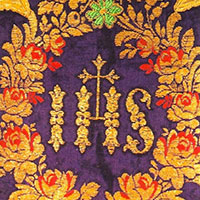 My PhD research project at the University of Canberra, Treasured Threads: Ecclesiastical Textiles as Living Heritage of the Catholic Church in Australia (2019), grew out of my BA (Hons) dissertation which was inspired by three fragments of historical ecclesiastical embroidery salvaged from old, worn and damaged vestments made obsolete following the reforms of the Second Vatican Council. Vatican II reduced the number and type of ecclesiastical garments worn by clerics and simplified vestment design. As a result, a large amount of ecclesiastical textile heritage was removed from service. Visiting heritage textile collections and speaking with custodians has uncovered a diverse and unexpected web of community and personal significance and values that connect this living textile heritage to a broader web of local, national and international history and ongoing cultural life. Continue reading “An Unexpected Heritage Treasure: The Chasuble”
My PhD research project at the University of Canberra, Treasured Threads: Ecclesiastical Textiles as Living Heritage of the Catholic Church in Australia (2019), grew out of my BA (Hons) dissertation which was inspired by three fragments of historical ecclesiastical embroidery salvaged from old, worn and damaged vestments made obsolete following the reforms of the Second Vatican Council. Vatican II reduced the number and type of ecclesiastical garments worn by clerics and simplified vestment design. As a result, a large amount of ecclesiastical textile heritage was removed from service. Visiting heritage textile collections and speaking with custodians has uncovered a diverse and unexpected web of community and personal significance and values that connect this living textile heritage to a broader web of local, national and international history and ongoing cultural life. Continue reading “An Unexpected Heritage Treasure: The Chasuble”
Glass and St Bede’s
 In the same way that churches have been built by Christians for two millennia, the small stone church in the Sydney suburb of Pyrmont, dedicated to St Bede the Venerable, was built by the hands of its parishioners. Much of the sandstone used to build the early buildings of Sydney was quarried in Pyrmont, the same stone that the parishioners cut from the site, shaped and laid to build St Bede’s. They completed the building in 1867 providing for a congregation of about 120 to gather for Mass. Continue reading “Glass and St Bede’s”
In the same way that churches have been built by Christians for two millennia, the small stone church in the Sydney suburb of Pyrmont, dedicated to St Bede the Venerable, was built by the hands of its parishioners. Much of the sandstone used to build the early buildings of Sydney was quarried in Pyrmont, the same stone that the parishioners cut from the site, shaped and laid to build St Bede’s. They completed the building in 1867 providing for a congregation of about 120 to gather for Mass. Continue reading “Glass and St Bede’s”
